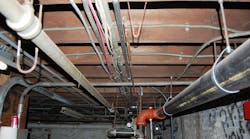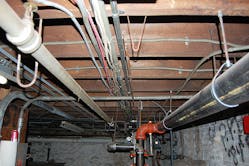How well do you know the Code? Think you can spot violations the original installer either ignored or couldn't identify? Here's your chance to moonlight as an electrical inspector and second-guess someone else's work from the safety of your living room or office. It's your turn to identify the violation.
Hint: Took the easy way out
Find the Answer
Unfortunately, I see this problem quite often in unfinished basements. These NM cables are run along the bottom of the floor joists, or simply secured to an existing pipe run along the bottom of the joists. In either case, the installer violates the installation requirements for this type of wiring.
Smaller NM cables like the ones in the photo are not permitted to be installed along the bottom of the joists in unfinished basements. Section 334.15(C) does, however, permit cables with not less than two 6 AWG or three 8 AWG conductors to be secured directly to the lower edges of the joists in this manner. Smaller cable though, are required to be installed on running boards or installed through holes drilled in the joists.
Securing cables to an existing EMT is also taking the easy way out. This method also violates the rules of the Code. Section 300.11(B) generally does not allow cables to be secured to raceways in this manner. These improperly supported cables can put extra strain on the raceway and its fittings, as well as affect the current-carrying capacity of the wires in the pipe, since these cables attached to the pipe’s exterior can trap the heat generated from the current flowing on the wires in the pipe as well as generating their own heat from current flow.





